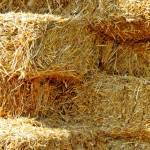Horses Show Preference for Straw Bedding

In a German study, warmblood horses were bedded on wood shavings, loose straw, or straw pellets. Behaviors such as eating hay, lying down, and nosing through bedding were recorded for each horse during its time in the stall, which totaled about 15 hours each day.
Results showed that all horses spent more time lying down when they were bedded on loose straw. They also spent more time sifting through the straw or otherwise investigating it than with other types of bedding.
The researchers noted that stalled horses face hours of boredom, and a bedding material that invites investigation and lying down might reduce the number of ritualized behaviors such as cribbing and weaving that may develop when horses are stabled for long periods.
Straw bedding has several drawbacks, however. One is the dust and mold spores that may be present. When horses lie down in straw bedding, they tend to inhale more airborne particles because their noses are closer to the straw than when they are standing. Horses that are sensitive to these particles may develop breathing problems that can be avoided by using a material that is free of dust and mold. A second drawback is that some horses are tempted to eat straw, an undesirable habit from both a health and a nutrition viewpoint.
Bedding choices tend to reflect availability, price, and ease of handling, with the horse’s health and comfort paramount in importance.








